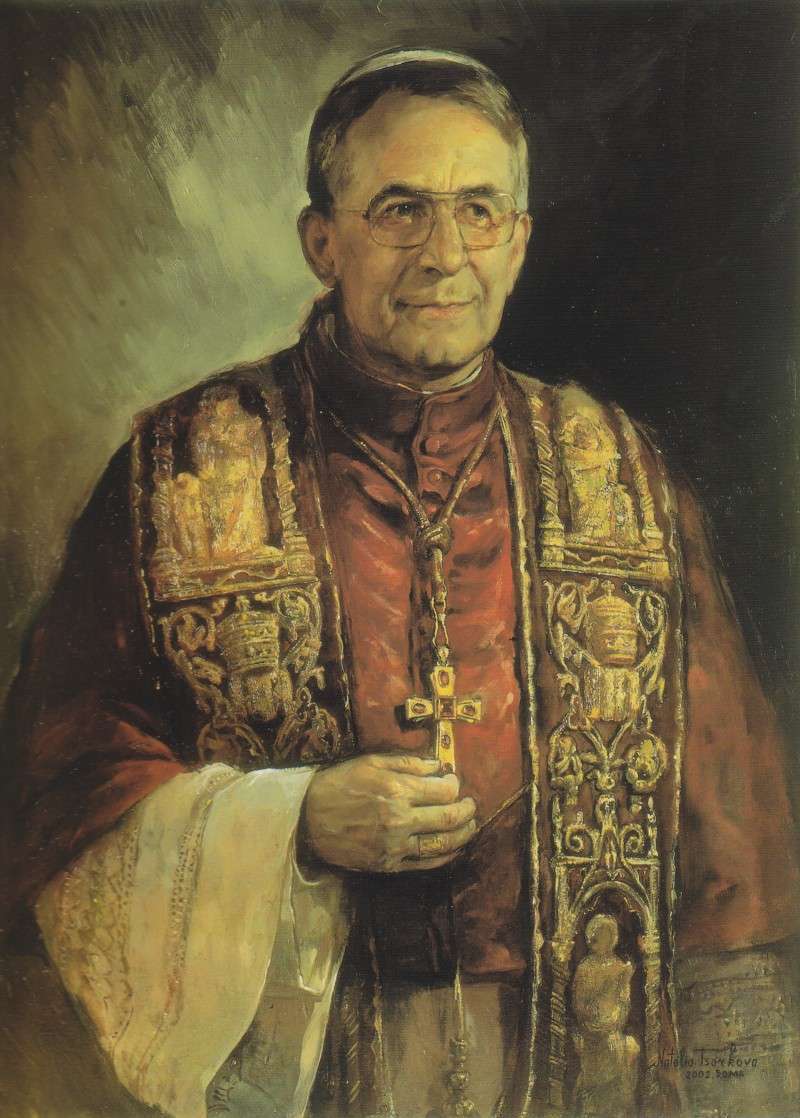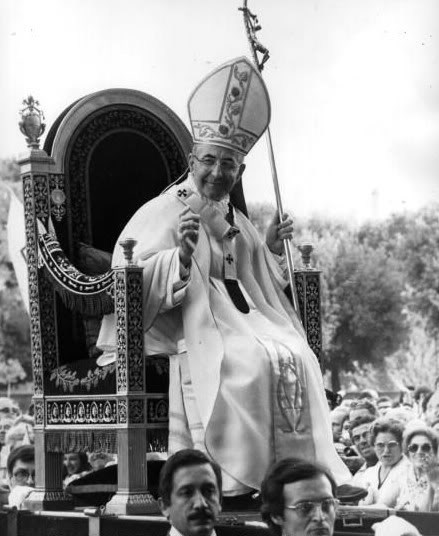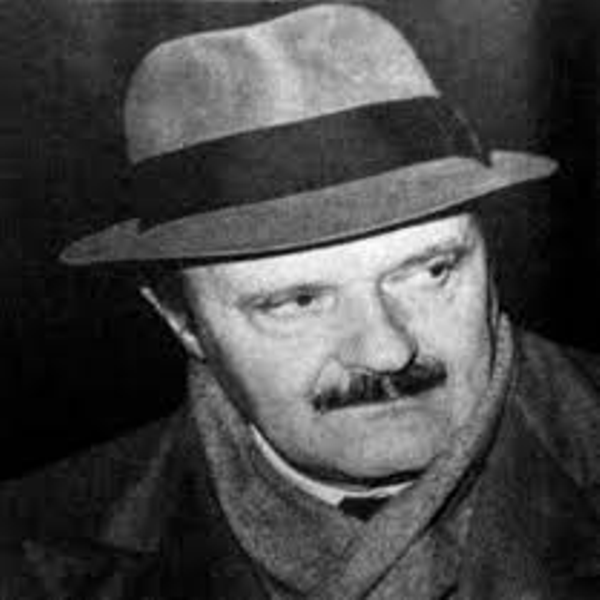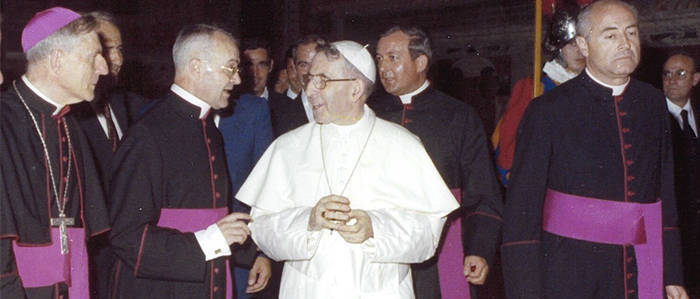Pope John Paul I: Murder and Corruption in the Holy City
Posted on 30th June 2021
On 6 August 1978, the aged and ailing Pope Paul VI died. The liberal reforms he had introduced during the Second Vatican Council had divided opinion within the Church and caused a great deal of resentment among its more conservative elements and so his death was greeted with a sigh of relief by some, but the choice of his successor was to be a shock to a great many.
The future Pope John Paul I was born Albino Luciani on 17 October 1912, in the town of Canale d’Agordo near Venice. He was of modest background, the son of a bricklayer, and as a young man he was considered too fun loving to be taken seriously but he was nonetheless determined to fulfil his childhood ambition to become a Catholic priest and was to surprise everyone with the determination he showed in his pursuit of what he considered his calling.
Despite his dedication in 1923, his application to join the Jesuits was denied but undeterred he went onto study for a doctorate in theology while continuing to fulfil his pastoral duties and teaching obligations at the Seminary in Belluno.
Father Luciani’s rise through the ranks of the Catholic Church was steady rather than spectacular and was very much down to his own hard work rather than any contacts he had within the Church hierarchy.

On 15 December 1958, at the age of 46, he was appointed Bishop of Vittorio Veneto and between 1962 and 1965 he was to participate in all of the sessions of the Second Vatican Council.
Always amiable and approachable with a winning smile and the ability to communicate he oozed human warmth and those who met him were impressed by both his humility and his honesty, but he was not an assertive man and did not cut an outstanding presence among his peers. He had been a supporter of the reforms of the Second Vatican Council but by no means a forceful one. He rarely, if ever, argued his opinions forcibly and was only too willing to listen to the views of others. Some considered his easy-going nature to be a sign of weakness, others of idiocy, while most who met him appeared to like him.
On 3 February 1970, he was appointed the Cardinal of San Marco.
Following the death of Pope Paul VI, the College of Cardinals gathered at Castel Gandolfo to begin the process of electing a new Pope and rumours soon began to circulate of serious divisions with the Conclave.
Conservatives within the College eager to reverse the reforms of the Second Vatican Council supported the candidacy of Giuseppe Siri, Archbishop of Genoa, but he was a controversial figure with a chequered past who it was rumoured had turned a blind eye to the activity of priests who established escape lines for wanted Nazi’s at the end of the War and would later oppose the election of Pope John Paul II on the grounds that he was too liberal.
It was also said that he had twice before come top on the First Ballot in both 1958 and 1963 but that on both occasions he had been persuaded to withdraw his candidacy. If so, he never spoke of it.
IIn 1978 he was again forced to withdraw his candidacy which appeared to leave the way clear for Giovanni Benelli, Archbishop of Florence but it transpired that he was too moderate and liberal for most conservatives and unable to acquire enough ballots to secure his election it soon became clear that a compromise candidate would have to be found.
The torch was now handed to the popular but neither much respected nor admired, Cardinal Luciani.
At 6.24 pm on the evening of 26 August 1978, white smoke appeared above the Sistine Chapel signalling the election of a new Pope to the crowds thronging St Peter’s Square below. Deacon Pericle Fellici then appeared upon the balcony of St Peter’s Basilica to announce the name of Albino Luciani as Pope John Paul I who now stepped forward to accept the acclaim of the people. They were ecstatic so much so that he was forced to reappear on several further occasions simply to appease them.
The election of a new Pope had taken place but at a time when the Vatican itself was mired in a corruption scandal and elected on the fourth ballot it was evident to everyone that the new Pope was a compromise candidate. At a particularly sensitive time for the Vatican, it was believed Cardinal Luciani had been elected Pope because he would not delve too deeply into the scandals that beset the Church and threatened to undermine it.
The Instituto per le Opere Religiose, or the Institute of Religious Works, better known as the Vatican Bank, held a great many shares in the Banco Ambrosiano possibly to the value of a quarter of a billion dollars. They used their links with the Banco Ambrosiano to filter funds to the anti-Communist Solidarity Movement in Poland and to various right-wing dictatorships in South America. This they did aware that the Banco Ambrosiano was corrupt and laundered money for the Mafia.
The President of the Vatican Bank was Archbishop Paul Marcinkus, an American who was also the Vatican’s Secretary of State and second only to the Pope in the Church hierarchy.
Marcinkus was a worldly man with an uncertain past who was a close friend of the Banco Ambrosiano’s Chairman, Roberto Calvi, and similarly to the corrupt Mafia Banker Michele Sidona who had been murdered while serving a prison sentence when his coffee was laced with cyanide.
The Vatican Bank is also believed to have had links to the Masonic Lodge P2, or Propaganda Due, and its leading member the shadowy Licio Gelli.
P2 with its authoritarian, some might say fascist agenda, acted as a clandestine political organisation within Italy and had among its members former Prime Ministers, Members of Parliament and the Judiciary, leading Industrialists, and Chiefs of the Italian Intelligence Service and Army. Indeed, so embroiled with P2 was the Italian Political Establishment that they formed an effective Shadow Government.
P2 plundered funds from the Banco Ambrosiano to pay its members and to bribe politicians. It was also implicated in some of the worst terrorist atrocities committed in Italy during the 1970’s and 1980’s including the bomb attack on Bologna Central Station that killed 85 people and injured more than 200.

This was the Vatican that Pope John Paul – a naturally modest man who had initially refused to use the Sedia Gestoria, the mobile throne upon which the Pope was carried before addressing the faithful and had declined the traditional Papal Coronation for a simple Inauguration Mass – now found himself in charge of, a Church mired in corruption where those at the very top were linked by association at least to the most appalling crimes.
He could either turn a blind eye to this or try to do something about it and Albino Luciani had never turned a blind eye to evil in his life and he wasn’t about to start now. Many believe it was his desire to clean up the Vatican that would lead to his death.
Considered by some within the confines of the Vatican to be a theological and intellectual lightweight Pope John Paul I did not appear to engender a great deal of respect. One high ranking official even referred to him as being retarded. Also, his discursive manner of speech, his lack of condescension, and his frequent references to popular culture earned him only scorn. One Archbishop even said the College of Cardinals had elected an idiot.
For a man who exuded warmth and enjoyed the company of others the frosty atmosphere and chill-wind that swept through the corridors of the Vatican must have made it a very lonely place.
Early on the morning of 29 September 1978, just 33 days into his reign Pope John Paul I was found sitting up dead in his bed by a Nun, Sister Vicenza. The 66-year-old Pontiff appeared to have died of a heart attack but this was not the whole story as the details of his death soon became blurred, stories were changed, evidence suppressed and questions went unanswered. What occurred that morning remains a mystery.
Rumours began to circulate that the Pope had been discovered holding a series of papers referring to the activities of the Vatican Bank, if so these papers were later burned.
Different versions of exactly when the Pope died and by whom the body was discovered were released to the press, and as was traditional no autopsy was carried out so delaying issue of the death certificate.
Some of those who witnessed the death scene later testified that among the papers the Pope was holding was a list of leading members of the Curia that were to be handed over to the Authorities for investigation and that among these names was that of Archbishop Paul Marcinkus.
Is it possible that the Pope had discovered many priests within the Vatican who were Freemasons with connections to the P2 Lodge? Freemasonry is considered atheistic and anathema to God and it is not permitted to be a practising Catholic and a Freemason.
Not long after his death many of the Pope’s closest associates died in mysterious circumstances including his personal assistant who was killed in a traffic accident within the Vatican City. Indeed, the deaths had started earlier when his close friend and most loyal supporter Metropolitan Nikidimov of Leningrad, collapsed and died during his installation.

Suspicions regarding the official version of Pope John Paul’s death began to emerge following the discovery of Roberto Calvi’s body hanging from Blackfriars Bridge his pockets stuffed with bricks. His death was initially ruled a suicide but so suspicious were the circumstances surrounding it that a second inquest was ordered which subsequently recorded an open verdict.
Further investigations into the death of ‘God’s Banker’ soon revealed links between Banco Ambrosiano, the Vatican, the Mafia, the P2 Masonic Lodge and money laundering.
In July 1991, Francesco Mannoia, a Mafia Informer, told the Police that Calvi’s murder had been carried out by Francesco di Carlo on the orders of Mafia Boss Giuseppe Calo and Licio Gelli.
In October 2005, five people went on trial for the murder of Roberto Calvi – Giuseppe Calo, Flavio Carbone, Ernesto Diotallevi, Silvano Vittor, and Manuela Kleinszig. On 6 June 2007, all five were cleared due to lack of evidence and with their acquittal all further investigations into the Banco Ambrosiano and consequently the circumstances surrounding the death of Pope John Paul I were conveniently brushed under the carpet.
Tagged as: Modern
Share this post:





